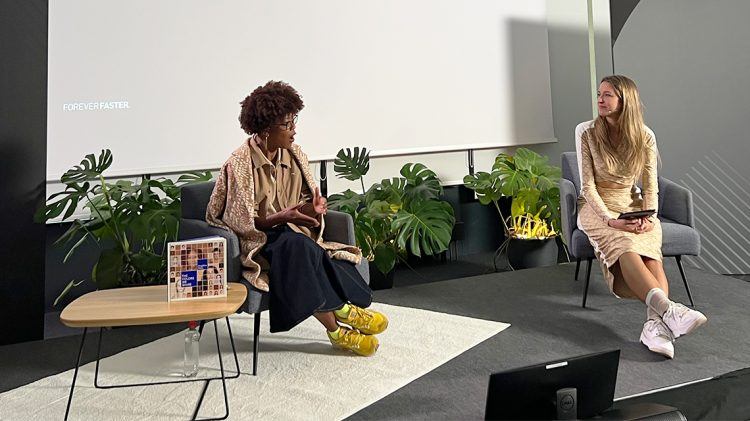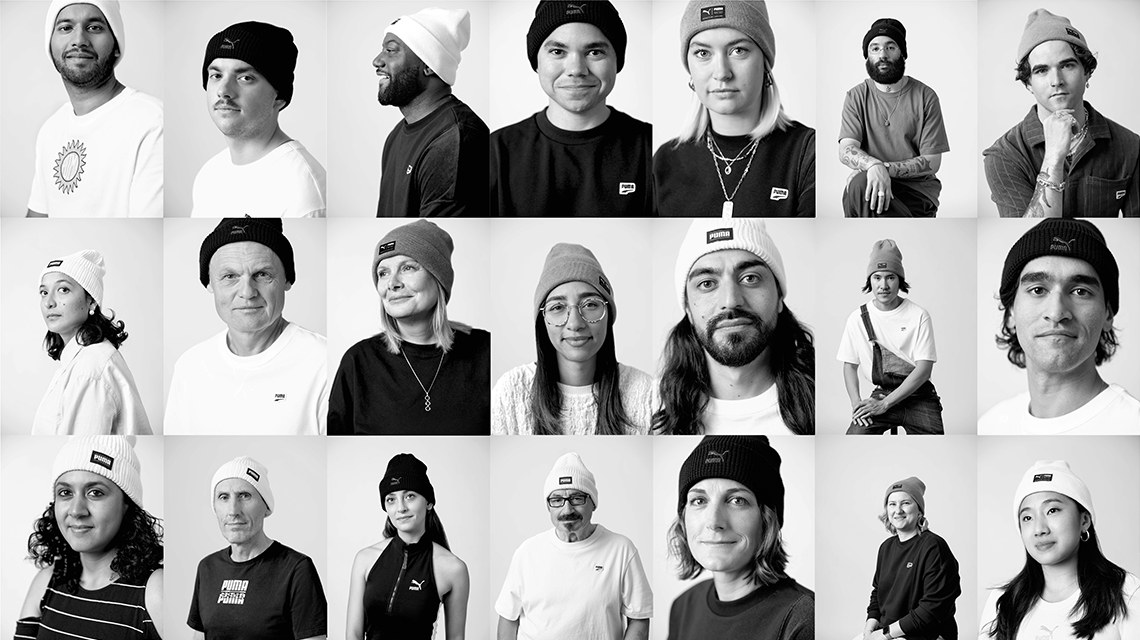
"I am an activator of conversations"
Interview with PUMA Beanie Campaign Photographer Angélica Dass on the Power of Art
October 28, 2022Interview with PUMA Beanie Campaign Photographer Angélica Dass on the Power of Art
October 28, 2022You may have seen our recent Beanie Campaign, and now you can hear from the mastermind behind it! Last week, we welcomed Angélica Dass to our PUMA headquarters for a globally streamed talk on the messages she shares through her art. Angélica’s work with PUMA aims to provoke conversations about identity and equality and urges people to rethink racial differences. Some PUMA employees attended the talk in person, with other joining online from all over the world!
At PUMA we encourage these discussions in order to create an open and safe environment for all of our employees – and we were lucky enough to learn more about the topic from Angélica! CATch Up had the opportunity to sit down with Angélica and talk about her goals as a photographer and how she defines her work. Check out the inspiring interview below!
The press often refers to you as a Latin American art activist. Does that match your perception?
Angélica: I am Latin American, but I am also European. There are so many layers to this and it’s funny how people really have the need to just pick one or the other. Being an art activist, I’m someone that uses my job, my skills to really try to provoke conversations in our society. So I know that I’m a photographer, this is what I study and I can classify myself as a photographer – but I think that we all have the possibility to be activists. What type of activist? I think that I’m an activator of conversations, and this is the point of the things that I do. I can activate different conversations using my work as a photographer. So yes, it’s a good tag, but I think that we all can be activists.
How do you want your art to affect people?
Angélica: I really believe in the power of art to be able to generate conversations, to be the starting point of a collective reflection. I like to quote Tupac Shakur who used to say, “I’m not going to change the world, but I guarantee that I will spark the brain that will change the world.” I think that this is the point about my work and about art and photography. My goal is to be able to spark brains, to really open minds, to really be able to connect people in a global conversation. And I think that this has to happen in the different layers of our society. So that’s why I’m happy to be in a museum, I’m happy to be in the middle of the street, but I’m also excited to be working with kids in school and in a big company like PUMA. We will just provoke these changes, that we may be able to achieve in the future, if we all as a society are part of a global conversation.
Let´s talk a bit about your amazing “Humanæ” art project, with over 4,000 portraits. How did you find all the people to take pictures of?
Angélica: The beautiful thing about “Humanæ” is that I didn’t find them, they found me. I just provoked the situation, and they were there. All I do are open calls: I put the studio, it can be in a museum or it can be in the headquarters of an NGO, and put some photos and I share with the people around. This can be online, or for example, when I was working in a favela in Rio de Janeiro, we spoke with the leaders. On the first day, we only had five people and on the second we had more. I love the idea of really thinking about the conversation, something that you share with others, and they then share and say “oh, you have to come to this place!”, so a lot of people came.
Having open calls is an important point of this project because the first thing I ask when people arise in the street is, “why are you here?”. You know that I put your photo in the middle of the street. You know that this is an anti-discrimination, anti-racism project. What connects you with my own personal story? It’s really beautiful because this is the real point of connection and to hear people explain “I’m here because I want to be alive”, “I’m here because I have a story that’s similar to yours”, or “I’m here because I have all the things, who I am, that are used to dehumanize me”.
This can be a sexual orientation, it can be different things that sometimes we as human beings use to dehumanize other human beings. So, they found me because there is a point of connection between us.
What is the goal of this project?
Angélica: I think that my main goal is to really provoke a dialogue when we are speaking about how we humanise and dehumanise human beings, how we are able to celebrate that we are all different, that we are all unique, but at the same time, we are all members of the human species. I think that the only way to recognize and really be able to see that is when we look at each other and when we talk with each other. That is what I urge in these photos. I invite you to create a kind of mural with all these faces that don’t look like you, that are from all over the globe. I think that when you are able to see yourself in the other, there is this point of connection that can make us sit and talk with each other and try to recognise these differences and live with this difference with respect. So I think that the main goal is exactly sit and talk, provoke the dialogue, provoke this mirror, provoke this conversation.
“I don’t think I will be able to really change the world, but I can prove that I can generate beautiful conversations about who we are as human beings.”
Angélica Dass
You once said: “I am sure that nobody is ‘black,’ and absolutely nobody is ‘white.’” The photos of our PUMA employees you took are shown in black and white. How did you come up with this idea? How would you like people to perceive the art?
Angélica: Because they are not black and white, they are shades of gray! My point when we are speaking about black and white or color, is that we are all shades. The two extremes don’t really exist when you think about human beings. The only thing that is black and white when you look at the photos, are the clothes. But when you see the people, they are all shades of gray. When you see these shades, you see exactly the same pigments, the same colors and the same layers. I insist that when we speak about human beings as black and white, there is a reason why we choose these words. And there is a historical moment when we choose to define someone as black and white, and especially when we add some adjectives to one color or toward the other.
How do I explain that? That’s why I love to work with kids. Kids have no idea that I’m black and that you are white. There is someone that had to teach them this concept and for me, this is the big thing. What we are teaching, what we are sharing with these new generations, what does this code mean – it is important to understand where this language came from.
This way we can recognize all our mistakes and really try to generate new conversations in the future where we recognize that looking at each other as black and white is limited because we are all shades of gray. There are some parts of you that are similar to mine, even if we have, of course, different skin tones, different ethnic backgrounds, different nationalities. There are points that we will have in common just because we are humans.
At PUMA, we recently won a diversity award and want to engage in open discourse and ensure that everyone feels they can be themselves. Do you have any advice on how we can further contribute to an inclusive workplace?
Angélica: Continue provoking these conversations, creating safe spaces for employees to be able to share their own stories. I think that just inviting someone like me to be here, just sharing and learning and connecting, is such amazing opportunity for the people that pose for me. They are people that knew my work, that share their personal stories, they speak about their family. It is the spaces for conversations that are important. I think that is very important in a company that is really focused on improving the way they deal with diversity, by showing beautiful work both inside and on the outside.

